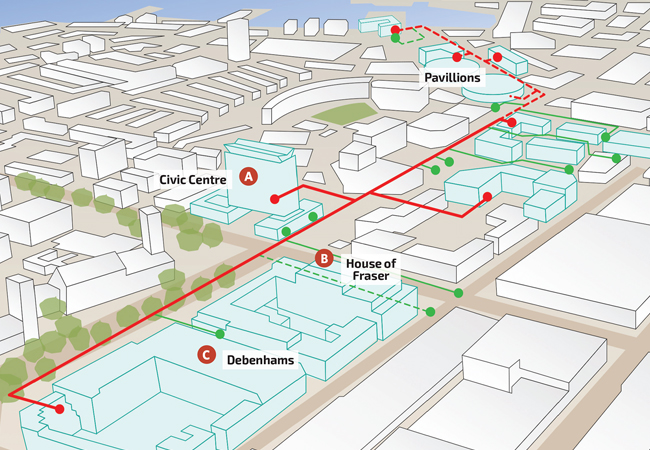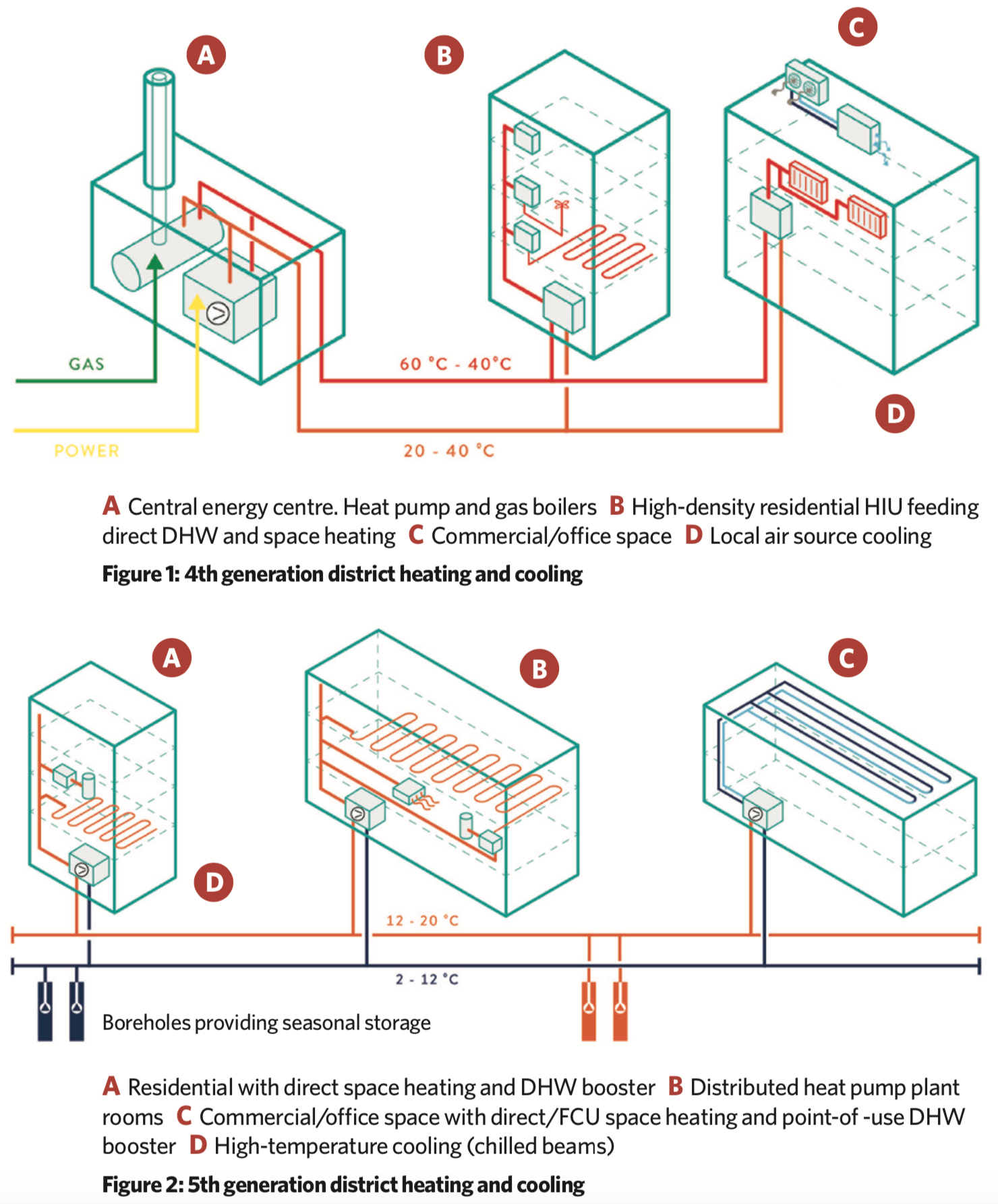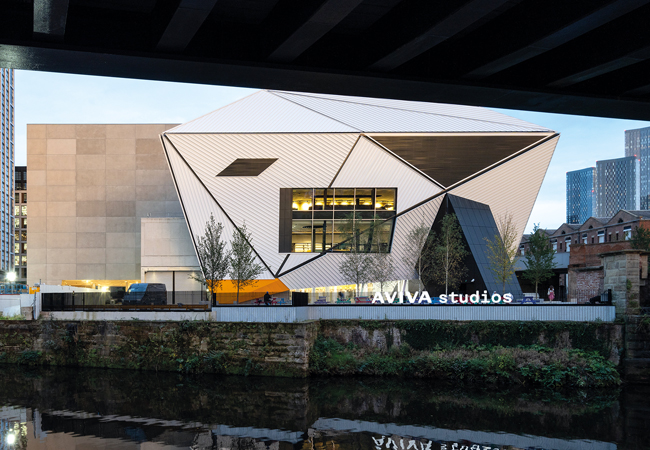
The construction of Plymouth City Council’s 5th-generation district heating and cooling (5DHC) network began last month. It started with the drilling of the first well into the aquifer that flows through the limestone strata on which areas of the city are built.
This pioneering low-carbon project will supply a cluster of buildings in the city centre with heat and coolth. It is one of several district energy schemes being explored by the council as part of its initiative to reduce carbon emissions.
‘Generating heat represents the biggest energy use in the UK so, to meet our target of reducing greenhouse gas emissions by at least 80% by 2050, we will have to decarbonise nearly all heat generation in buildings and most industrial processes,’ says Jon Selman, low carbon city officer in the Strategic Planning and Infrastructure Service at Plymouth City Council.
‘Reducing demand for heat through improved energy efficiency will be important but it will not be enough to meet the 2050 target. This is where heat networks have a role to play.’
Plymouth City Council never set out to pioneer the use of 5DHC, which features no central energy centre and uses local heat pumps to heat and cool buildings. But it was participating in the HeatNet project (co-financed by the European Regional Development Fund) to explore the implementation of 4th-generation district heating and cooling (4DHC) networks in the city. ‘Conventional heat networks typically deliver hot water at 80oC, usually heated by gas boilers or a CHP engine housed in an energy centre,’ says Selman.
‘Fourth-generation district and cooling networks feature an energy centre supplying heat outwards to buildings, but they usually operate at a lower temperature than conventional networks [around 55oC], resulting in lower capital costs, lower heat losses and greater energy efficiency.’
The 4DHC networks were of interest to the council because their lower temperatures offered the city the opportunity to use waste heat and renewable heat sources, such as ground source. ‘Plymouth is one of the pilot areas to demonstrate the application of this approach,’ says Selman.

Mapping heat loads
Under the HeatNet project, the council commissioned BuroHappold and Building Energy Solutions to map the heat loads and heat sources for the city. The mapping indicated multiple heat sources in Plymouth including: an energy-from-waste plant; a potential sea water source heat pump; groundwater source heat pumps; data centre heat recovery; and incinerator heat recovery.
Seven clusters were defined to benefit from the heat sources. BuroHappold then developed an outline design and costing to turn these clusters into heat networks and a roadmap for the city-wide implementation of the 4DHC network.
The HeatNet project team visited a scheme in Heerlen, Netherlands, called the Mijnwater (Minewater) project. The scheme is based around two flooded mine shafts, one of which is kept warm, the other cold, to provide seasonal storage. The mine shafts are connected by a warm and cold header with a common return.
What makes the Mijnwater scheme radically different from all previous generations of district heat and energy networks is that it does not have a conventional energy centre. Instead, each building incorporates a heat pump connected to the warm and cold headers that supplies each building on the network with heat or coolth as required, from only two pipes. When in cooling mode, the heat pumps reject heat into the header.
‘It means one person’s cooling can be another person’s heating,’ says Selman. ‘That exchange of heat might take place simultaneously or across the seasons, which is why you need the thermal storage,’ he adds.
Mijnwater’s decentralised heat pump approach moved the concept of thermal smart energy networks onto a new level – 5DHC (see Figure 2).
Fifth amendment
‘A rough metric in deciding whether a 5DHC network will be appropriate is that more than 40% of the load must be cooling,’ says Selman.
Following the visit, Plymouth City Council ‘revisited its existing 4DHC proposals and viewed them through a 5DHC lens,’ Selman says. It found there were sufficient commercial buildings in the centre of Plymouth with a cooling demand to meet the 40% characteristic.
‘We explored the city centre idea in more detail based around some areas of the city that the council has control of, along with some new development areas over which the council will have influence,’ says Selman.
‘What we’re trying to do to develop this scheme is to create a low-temperature building zone, centred on the city council’s offices, where any new buildings will need to be designed around a low temperature heating system wherever possible.’
The scheme is particularly appropriate for this area because of the balance of heat in winter and cooling demand in summer. It is much more efficient for cooling to be provided by heat pumps, which reject heat into the low-temperature circuit, than to use chillers rejecting heat into the outside air.
Selman says the cooling aspect of 5DHC projects are ‘a real bonus, particularly as the climate warms, because they can deliver cooling in a more efficient way than a traditional district energy scheme, which gives some flexibility and resilience because the business model is not just focused on heat’.

The House of Fraser department store will be on the network. Credit: iStock - Guy N Harris
Similarly, the low-temperature thermal network is ideal for heating new buildings with underfloor heating using a heat pump. However, a higher temperature heat pump could be used to deliver heating to an older building with, say, a radiator-based heating system. ‘With new buildings, you can drive down the heating temperatures more than would be possible with retrofit,’ says Selman.
He says the current financial viability of the 5DHC scheme is based on the assumption that the Renewable Heat Incentive (RHI) will still be available in two years’ time. ‘There is a question about the existence of the RHI post 2021, without which the economics of the scheme may not stack up,’ warns Selman.
Instead of using abandoned mine shafts, as in the Netherlands, the Plymouth scheme uses geology. ‘We looked at the geology underneath Plymouth and found a thick belt of limestone that has a principal aquifer running through it with a significant flow of water from east to west that we could use as a heat or cooling source or potentially for heat storage,’ says Selman.
The wells being drilled by the contractor are the first step forward on the 5DHC scheme – ‘the system will use an abstraction well and recharge well to balance the ultra-low temperature headers. These will require an Environment Agency licence to abstract water’, Selman says. ‘Eventually, we’d like to tie in the system with a marine water source heat pump as well, where the new network meets the water’s edge.’
The plan is for a two-pipe network to link the developments to enable them to share energy; the warm pipe is expected to be at around 14oC – roughly the temperature of the ground – and the cold pipe at 6oC, so there is no need to insulate the pipes.
‘The ultra-low temperature network will allow usually rejected energy to be recovered and shared within, as well as between, buildings that are heating and cooling, simultaneously reducing primary energy and increasing system efficiency,’ says Justin Etherington, associate director at BuroHappold Engineering. Depending on the results from the well excavation, surplus energy is expected to be stored in the ground to keep the system in balance.
Building heat pumps
Heat pumps within each building provide heating or cooling as required. ‘This is a very neat solution that allows a building to connect with two pipes, from which you can satisfy both the heating and cooling demand, meaning a building doesn’t need flues, gas connection, roof-top chillers or plant,’ Etherington says. In each building, the heat pump is connected to a thermal store. This enables the building to meet peak demand without the need to size the heat pumps accordingly.
The storage also gives Plymouth City Council the ability to decouple loads from the system, so it could use the system in a dynamic demand response mode. ‘You could use the heat pumps in communication with the power grid as part of a multi-vector response, for example, power prices spike between five and seven o’clock, so you could manage the thermal store to avoid running the HPs at that time,’ says Etherington.
It is early days for the 5DHC network at Plymouth. The HeatNet team is focused on identifying local opportunities to achieve a working installation of a smart thermal energy network in Plymouth. The hope is that the learning from this project can inform UK-wide guidance to encourage others to follow similar approaches.
■
The project and the lessons for similar developments was presented at the 2019 CIBSE Technical Symposium by Phil Jones of Building Energy Solutions, who has been involved in the project,
■
Read about the 5DHC balanced energy network at South Bank University
‘Intranets for heat’, May 2019, CIBSE Journal Commercial Heating Special,






